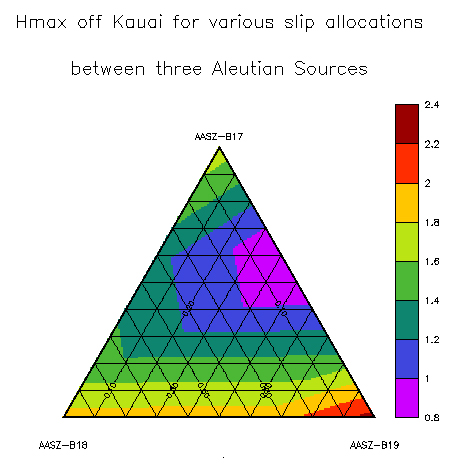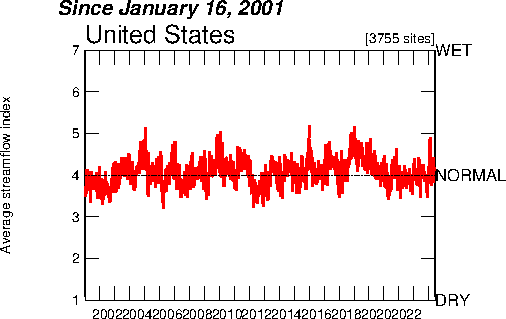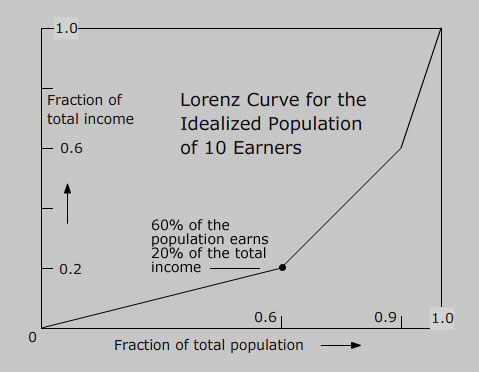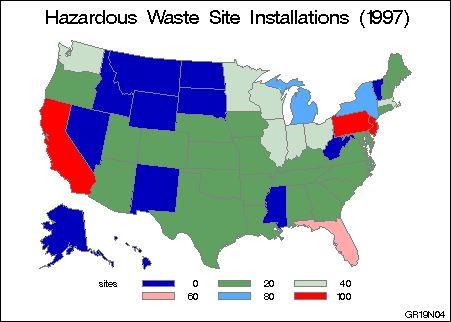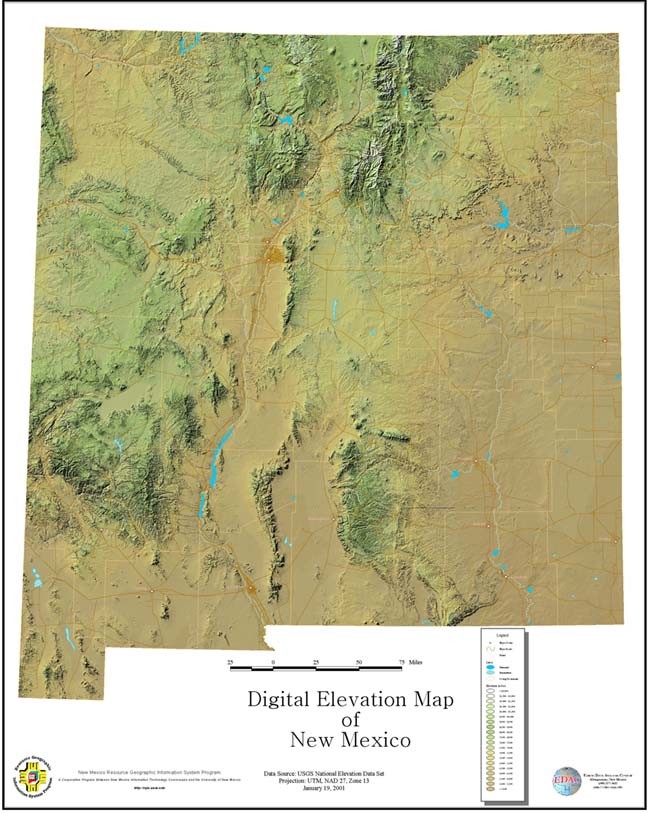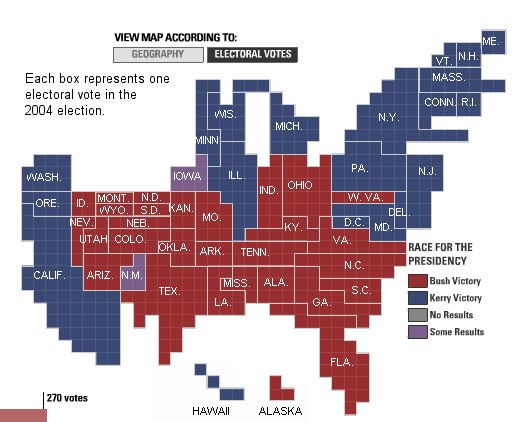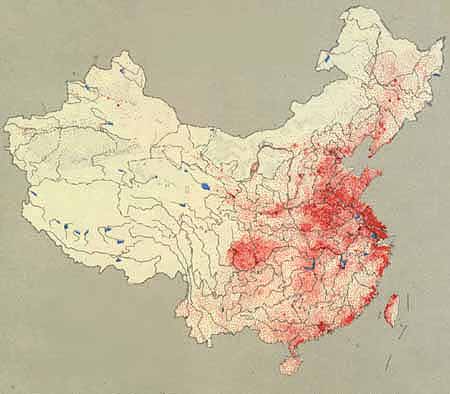
Friday, April 23, 2010
Unclassed Choropleth map

Classed Choropleth map
Range graded proportional circle map
Star Plots
Correlation matrix
Similarity Matrix
stem and leaf plot
Box plot
Histogram
Parallel coordinate graph
Triangular plot
Windrose
Climograph
population profile
Scatterplot
Index value plot
Lorenz Curve
Bilateral graph
Nominal area choropleth map
Unstandardized Choropleth map
Standardized choropleth maps
 This map shows the proportion of Canadians who are classified as obese. They are compared to the national average and then depicted in different colors on the map. The map also shows boundary lines within the country for easier understanding. The trend of interest is obesity and where it is located.
This map shows the proportion of Canadians who are classified as obese. They are compared to the national average and then depicted in different colors on the map. The map also shows boundary lines within the country for easier understanding. The trend of interest is obesity and where it is located.
Univariate Choropleth Map
Continuously variable proportional circle map
Bivariate Cloropleth Map
Digital Orthophoto Quarter Quadrangles (DOQQ)
DEM map
Digital Line Graph (DLG)
Digital Raster Graphics (DRG)
Isopleth Map
Isopach Map
 Isopach maps show the thickness of sediment deposits. In this map the thickness in meters of Tioga Bentonite is show with a dark black line. Tioga Bentonite was a deposit of sediment from a volcano eruption millions of years ago. From this map, researchers are able to study a volcanic eruption that occurred many years ago. The theme of this map is thickness of sedimentary deposits, but it also includes city boundaries and cities.
Isopach maps show the thickness of sediment deposits. In this map the thickness in meters of Tioga Bentonite is show with a dark black line. Tioga Bentonite was a deposit of sediment from a volcano eruption millions of years ago. From this map, researchers are able to study a volcanic eruption that occurred many years ago. The theme of this map is thickness of sedimentary deposits, but it also includes city boundaries and cities.
Isohyet Map

Isotach Map
Isobar Map
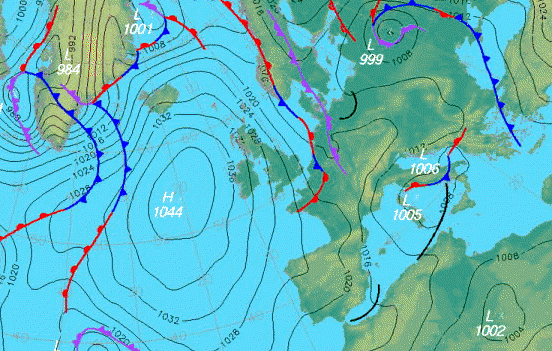 This map shows the pressure systems over the United Kingdom. The black lines are the isobars, which are indicating the points of equal pressure. It can be seen from this map that the wind is less over the ocean, as denoted by the wide-set lines. The anticyclones and depressions, labeled H and L respectively, are included. Also included are the warm and cold fronts. The theme of this map is pressure systems over the UK.
This map shows the pressure systems over the United Kingdom. The black lines are the isobars, which are indicating the points of equal pressure. It can be seen from this map that the wind is less over the ocean, as denoted by the wide-set lines. The anticyclones and depressions, labeled H and L respectively, are included. Also included are the warm and cold fronts. The theme of this map is pressure systems over the UK.
LIDAR
 This map shows New York city after September 11th, 2001. The map uses color and height to illustrate the elevation of the city. This type of mapping can also be used to map landscapes for the use of conservationists needing to see where land is declining. The trend in this map is showing the elevations of New York city.
This map shows New York city after September 11th, 2001. The map uses color and height to illustrate the elevation of the city. This type of mapping can also be used to map landscapes for the use of conservationists needing to see where land is declining. The trend in this map is showing the elevations of New York city.
Doppler Radar
 This map is taken from Doppler radar in Frederick, Oklahoma. It shows the strength of the storm in decibels. The color scale relates to the strength of the storm. The general trend of interest for this map is where the storm is located and how strong it is in certain areas. This map also contains highways and elevations for easier locating of the storm.
This map is taken from Doppler radar in Frederick, Oklahoma. It shows the strength of the storm in decibels. The color scale relates to the strength of the storm. The general trend of interest for this map is where the storm is located and how strong it is in certain areas. This map also contains highways and elevations for easier locating of the storm.
Black and White Aerial
This is a photo showing a map of waterways on a college campus in spring of 1997. The photo is labeled like a map in order to show where beaver's dams are located. The main roadways are also labeled. These kinds of maps help environmentalists track animals and their environment. The theme of this map is depicting where the animal's dams are located.
Infrared Aerial Photo
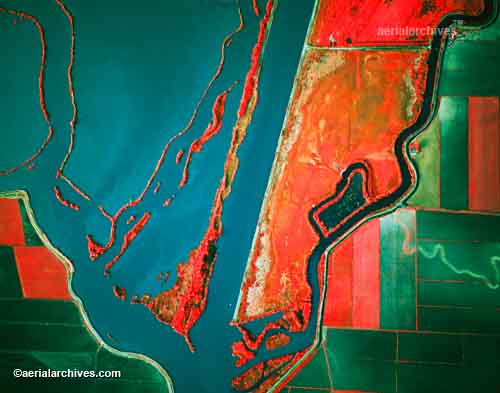 This image shows the deep water channel in Sacramento, California. This photo was taken using infrared radiation. This type of photographing can illustrate water, vegetation and many environmental changes much clearer than a typical color photo. This particular photo can be used to study the waterways and specific plants around that area.
This image shows the deep water channel in Sacramento, California. This photo was taken using infrared radiation. This type of photographing can illustrate water, vegetation and many environmental changes much clearer than a typical color photo. This particular photo can be used to study the waterways and specific plants around that area.
Cartographic Animation
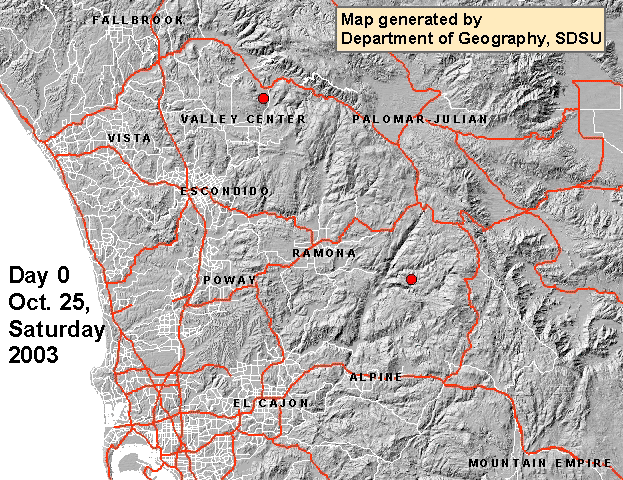 This animated map essentially shows where the fires were located during a week in San Diego in 2003. Major roadways and land elevations are included in the map. The animation also uses different colors to differentiate between total number of fires each day. The trend of interest in this map is where the fires are occurring and to what extent each day.
This animated map essentially shows where the fires were located during a week in San Diego in 2003. Major roadways and land elevations are included in the map. The animation also uses different colors to differentiate between total number of fires each day. The trend of interest in this map is where the fires are occurring and to what extent each day.
Statistical Map
 This statistical map shows the population density of people living in the United States per square mile. The trend of interest is seeing where most Americans live within the country. The map gives a visual representation of population density by using "spikes" that can be compared to each other by their height.
This statistical map shows the population density of people living in the United States per square mile. The trend of interest is seeing where most Americans live within the country. The map gives a visual representation of population density by using "spikes" that can be compared to each other by their height.
Cartogram
Flow Map
 This map shows the traffic flow of communication within Europe. By using lines that are thicker to show more volume of traffic and not including traffic that is beneath a certain limit, the map can be read clearly. This map also incorporates a dot proportional map, showing how large the major cities are compared to each other. The general trend of interest for this map is how and where the flow of telecommunication traffic is in Europe.
This map shows the traffic flow of communication within Europe. By using lines that are thicker to show more volume of traffic and not including traffic that is beneath a certain limit, the map can be read clearly. This map also incorporates a dot proportional map, showing how large the major cities are compared to each other. The general trend of interest for this map is how and where the flow of telecommunication traffic is in Europe.
Isoline Map
Proportional Circle Map
 The Mexican populations in the Western United States in 1990 is illustrated using proportionate circles. The size of the spheres correlates with the percentage of Mexicans living in that area. This map clearly shows where the highest and lowest populations of Mexican people are living. The trend of interest is seeing where Mexican people chose to live in the 1990's Western United States.
The Mexican populations in the Western United States in 1990 is illustrated using proportionate circles. The size of the spheres correlates with the percentage of Mexicans living in that area. This map clearly shows where the highest and lowest populations of Mexican people are living. The trend of interest is seeing where Mexican people chose to live in the 1990's Western United States.
Cloropleth Map
Dot Distribution Map
Propaganda Map
Hypsometric Map
PLSS Map

Cadastral Map
Thematic Map
Subscribe to:
Comments (Atom)








